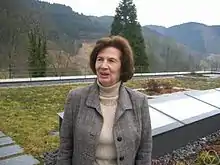Vera T. Sós
Vera Turán Sós (11 September 1930 – 22 March 2023)[1] was a Hungarian mathematician who specialized in number theory and combinatorics. She was a student and close collaborator of both Paul Erdős and Alfréd Rényi. She also collaborated frequently with her husband Pál Turán, an analyst, number theorist, and combinatorist. Until 1987, she worked at the Department of Analysis at the Eötvös Loránd University, Budapest. Afterwards, she was employed by the Alfréd Rényi Institute of Mathematics.[2] She was elected a corresponding member (1985) and member (1990) of the Hungarian Academy of Sciences.[3] In 1997, Sós was awarded the Széchenyi Prize.
Vera Sós | |
|---|---|
 Sós in 2008 | |
| Born | Vera Turán Sós 11 September 1930 |
| Died | 22 March 2023 (aged 92) |
| Nationality | Hungarian |
| Alma mater | Eötvös Loránd University. |
| Awards | Tibor Szele Medal (1974), Academic Award (1983), Széchenyi Prize (1997), Cross of the Hungarian Order of Merit (2002), elected to Academia Europaea (2013) |
| Scientific career | |
| Fields | Mathematics |
| Institutions | Eötvös Loránd University |
| Doctoral students | |
One of her contributions is the Kővári–Sós–Turán theorem concerning the maximum possible number of edges in a bipartite graph that does not contain certain complete subgraphs. Another is the following so-called friendship theorem proved with Paul Erdős and Alfréd Rényi: if, in a finite graph, any two vertices have exactly one common neighbor, then some vertex is joined to all others. In number theory, Sós proved the three-gap theorem, conjectured by Hugo Steinhaus and proved independently by Stanisław Świerczkowski.
Life and career
Vera Sós was the daughter of a school teacher. As an adolescent, Sós attended the Abonyi Street Jewish high school in Budapest and graduated in 1948. She was later introduced to Alfréd Rényi and Paul Erdős, with whom she later collaborated,[4] by her teacher Tibor Gallai. (Together, she and Erdős wrote thirty papers.) Sós considered Gallai to be the person who discovered her gift for mathematics. Sós was also one of three girls in Gallai's class to became mathematicians. Sós later attended Eötvös Loránd University. There, she studied as a mathematics and physics major and graduated in 1952. Although she was still a student, Sós taught at Eötvös University in 1950. At the age of twenty, Sós attended a Mathematical Congress in Budapest, Hungary and attended a summer internship. Sós met her husband and collaborator Paul Turán in college. They married in 1952. The two had two children in 1953 and 1960, Gyorgy and Thomas Turán.[5] Turán died in September 1976.
In 1965, Sós began the weekly Hajnal–Sós seminar at the Mathematical Institute of the Hungarian Academy for Science with András Hajnal. The seminar is considered to be a "forum for new results in combinatorics."[6] This weekly seminar continues to this day.
Throughout her years working in mathematics, Sós had been honored with many awards as a result of her work. One of the many awards includes the Széchenyi Prize, which she received in 1997. The Széchenyi Prize is an award given to those who have greatly contributed to the academic life of Hungary.
Awards
- Member of Academia Europaea, 2013
- Széchenyi Prize, 1997
- Academic Award, 1983
- Cross of the Hungarian Order of Merit, 2002
- Tibor Szele Medal, 1974[7]
Selected publications
- ——— (1958). "On the distribution mod 1 of the sequence nα". Ann. Univ. Sci. Budapest. Eötvös Sect. Math. 1: 127–134.
- ———; Kövari, T.; Turán, P. (1954). "On a problem of K. Zarankiewicz". Colloq. Math. 3: 50–57. doi:10.4064/cm-3-1-50-57. MR 0065617.
Notes
- "Elhunyt T. Sós Vera matematikus, az MTA rendes tagja" (in Hungarian). MTA. 22 March 2023. Retrieved 22 March 2023.
- List of research fellows of the Rényi Institute, retrieved 23 January 2010.
- Membership listing, Hungarian Academy of Sciences, retrieved 23 January 2010.
- Erdős, P.; Rényi, A.; Sós, V. T. On the problem of graph theory. Studia Sci. Math. Hungar. 1 (1966), 215–235
- Background Information Archived 7 February 2007 at the Wayback Machine on Sós (on pages 19–22)
- Same as Note 4 Archived 7 February 2007 at the Wayback Machine
- List of awards given to Vera T. Sós
References
- MTI Ki Kicsoda [Who's Who] 2009, Magyar Távirati Iroda Zrt., Budapest, 2008, pp. 1130., ISSN 1787-288X
- A Magyar Tudományos Akadémia tagjai 1825–2002 III. (R–ZS). [Members of the Hungarian Academy of Sciences 1825–2002, volume III.] Ed. Ferenc Glatz. Budapest: MTA Társadalomkutató Központ, 2003, pp. 1155–1156.
- "T. Sós Vera: Rend, Rendezetlenség és Ami a Kettő Között Van." Lecture. 6 November 2010. YouTube. YouTube, 24 January 2012. Web. 20 April 2013. <https://www.youtube.com/watch?v=c39uLbMGNEo>.
- "Magyar Tudományos Akadémia (Hungarian Academy of Sciences)." MTA. N.p., n.d. Web. 20 April 2013. <http://mta.hu/koztestuleti_tagok?PersonId=19476>.
- "A Matematikus T. Sós Vera 75 éves (The Mathematician Vera Sos 75 Years Old)." http://www.nol.hu. N.p., n.d. Web. <http://www.nol.hu/archivum/archiv-376708>.
- Babai, László (2001). "In and Out of Hungary: Paul Erdős, His Friends, and Times" (PostScript). University of Chicago. Retrieved 2008-06-22.<https://web.archive.org/web/20070207131035/http://www.cs.uchicago.edu/files/tr_authentic/TR-2001-03.ps>
- Sos, Vera T. "A Matematika Professzor Asszonya." Interview. A Matematika Professzor Asszonya. N.p., n.d. Web. 20 April 2013. <http://www.termeszetvilaga.hu/tv2000/tv0009/matematika.html>.
External links
- Order and Disorder on YouTube (in Hungarian), lecture given by Sós on 6 November 2010
- Vera T. Sós at the Mathematics Genealogy Project
- O'Connor, John J.; Robertson, Edmund F., "Vera Turán Sós", MacTutor History of Mathematics Archive, University of St Andrews